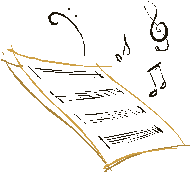Slash chords are chords that look like this:
C/Bb or F/A or G7/F etc.
Free piano lessons online covering piano chords, chord progressions, music theory, transposition, modulation, improvisation, sheet music lessons.
Monday, July 21, 2008
Improvising Piano Blues
Improvising the blues on the piano involves learning the structure of the blues as well as the blues scale.
How To Create A "Flowing River of Sound" on the Piano
Use open-voiced arpeggios in the left hand while playing broken chords in the right hand.
Half-Step Slides: Piano Chord Substitutions
One of the best ways to make an interesting chord substitution is to use 1/2 step slides. Substitute the chord that is 1/2 step above the target chord before you arrive at that chord.
How To Make a Piano Sound Like Bells & Chimes
You can make your piano sound like bells and chimes by learning two simple techniques -- one for bells and one for chimes.
What is a piano "Score"?
A piano score is a type of ensemble sheet music intended solely for the piano. Like all sheet music, it is a song's written notation; a piano score tells the musician what to play and how to play it. Unlike all sheet music, however, a piano score shows not only the piano part but nearly every other part in the ensemble as well. It can be a confusing piece of sheet music; the pianist must get used to following their part closely in conjunction with the other ensemble instruments. Traditionally, this is the job of the conductor. A normal conductor's score will notate every part of the ensemble in one large book of sheet music to aid the conductor in focusing on the various instruments. A piano score, however, is handled completely by the pianist. While it may mirror the score used by the conductor, it is rarely an exact replica; the notations, after all, are intended for an actual musician in the ensemble as opposed to the person directing it.
A piano score is used in a variety of different forms and genres; it knows no boundaries of style. The type of piano score used is often based solely on the type of music or ensemble. The pianist in a large ensemble, such as an accompanying orchestra to a theatrical performance, will often use a partial piano score. This type of piano score doesn't include every single instrument, just the parts vital to the pianist's understanding of the melody and rhythm; partial piano scores (despite being only partial) are still fairly detailed. A full piano score is usually only used by smaller ensembles, though even the small ensembles revert to a partial piano score at times. Jazz musicians particularly use a partial piano score even less detailed than a large orchestra's piano score. Due to the improvisatory nature of jazz music, detailed sheet music is rarely necessary; depending on the ensemble, the sheet music functions more as flexible notes than anything else. A piano score in jazz works in this manner. It gives the pianist vital reminders about the melody, rhythm or harmony, but allows for variations on the overall theme; a piano score here will only show what truly needs to be shown.
___________________________
